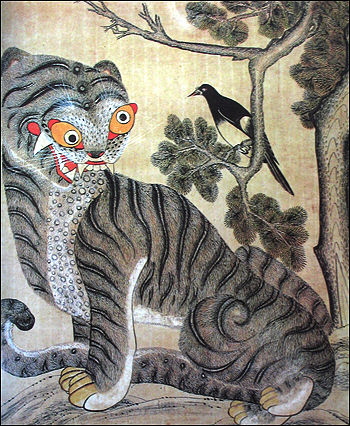Have you ever looked at old Korean paintings? If you have looked at Korean paintings, one of the most popular subjects has always been the image of a tiger. The roots of this subject can be found in Korean folklore. As far as the most famous Korean paintings called Minhwa, we can mention the genre of Kkachi Horangi (까치호랑이), which means Magpie Tiger, related to a folk story in Korean mythology. Besides the tiger, the Korean nine-tailed fox (Kumiho), the thousand-year-old turtle, and Doggaebi are also important symbols in Korean culture, but why does the tiger have the spotlight in Korean art and folklore?

The tiger is one of the twelve symbols of the zodiac and is therefore the symbol of many people's year of birth. Since ancient times, the tiger has been an important creature among the Korean people. Korea was called the land of tigers to the extent that the phrase ‘호랑이 담배 피우던 시절’ (in the time when tigers smoked) can be used to express that something belongs to distant times. The importance of the tiger goes back so far that in the legend of the creation of Korea, the tiger also plays a role. In the legend of Dangun, the tiger is one of the two animals that requested to become human but could not resist until the end to fulfill the necessary conditions.
In some folk tales, the tiger may seem like a weak or foolish creature, but generally, the tiger in Korea is a symbol of strength, power, humor, superiority, and the guardian spirit of the mountain in Buddhist culture. The tiger is a protector that can ward off evil spirits. In Korean paintings, the tiger looks as if it has a grin showing the humorous spirit of the Korean people. Tiger statues can even be seen in royal tombs. People believed that the tiger can protect the tomb of their dead.
Also, a tiger named Hodori was the official mascot of the Seoul Olympics in 1988, and a white tiger named Soohorang was one of the mascots of the Pyeongchang Olympics in 2018. The other mascot was a bear, which was probably related to the story of Gojoseon and the legend of the creation of Korea and the native Asiatic bear.


Below is the most important Korean folktale involving a tiger:
The story of the creation of Korea - Dangun
The Dangun myth is a Korean creation myth that tells the story of the founding of Korea. According to the myth, a god named Hwanung descended from heaven and settled on the sacred mountain of Taebaek. He wished to establish a kingdom on earth, and so he sent his son, Dangun, to rule over the land.
According to Korean mythology, a tiger and a bear prayed to the divine king Hwanung to become human. Hwanung gave them a challenge to eat only garlic and mugwort for 100 days in a cave. The tiger gave up halfway through, but the bear persevered and became a beautiful woman.
Hwanung descended from heaven on the 15th day of the 8th lunar month and established his kingdom at a place called Asadal. He married the bear that had transformed into a woman, and together they had a son named Dangun. Dangun ruled over his kingdom for 1,500 years before passing the throne to his son. The kingdom was eventually renamed Joseon and became the foundation of modern-day Korea.
The Dangun myth is an important part of Korean culture and is celebrated every year on October 3rd as National Foundation Day.
The story of the tiger and bear becoming human symbolizes the importance of perseverance and determination in achieving one's goals. It also highlights the belief in the power of prayer and divine intervention in Korean mythology.
Images by Korealimited and Seoul 1988 Organizing Committee via Olympics website
How about this article?
- Like7
- Support1
- Amazing9
- Sad0
- Curious0
- Insightful2


